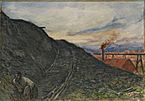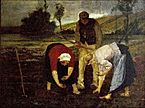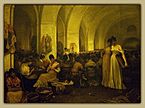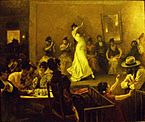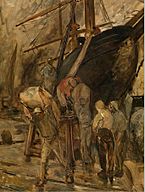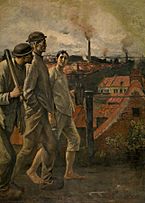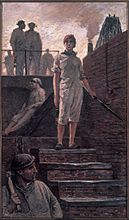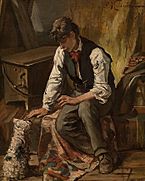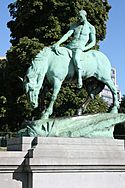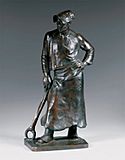Constantin Meunier facts for kids
Quick facts for kids
Constantin Meunier
|
|
|---|---|
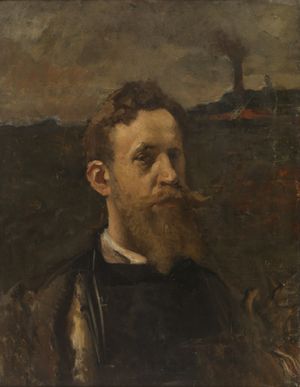
Self-portrait, 1885
|
|
| Born | 12 April 1831 Etterbeek, Belgium
|
| Died | 4 April 1905 (aged 73) Ixelles, Belgium
|
| Occupation | Painter, sculptor |
Constantin Meunier (born April 12, 1831 – died April 4, 1905) was a Belgian painter and sculptor. He is famous for showing the lives of everyday workers, like miners and factory workers, in his art. Meunier helped change how people saw these workers, making them important symbols in modern art. His artwork shows the big changes happening in society and industry during his time. He wanted to show a caring and dedicated view of people and the world.
Contents
Early Life and Art Training
Constantin Meunier was born in Etterbeek, a working-class area in Brussels, Belgium. His family was not rich.
He started studying sculpture at the Academy of Fine Arts in Brussels when he was 14. This was in September 1845. He learned from sculptor Louis Jehotte starting in 1848. He also studied in the private studio of sculptor Charles-Auguste Fraikin from 1852.
Even though he had some success as a sculptor, he saw a painting called The Stone Breakers by Gustave Courbet in 1851. This painting showed real-life workers. It made Meunier wonder if sculpture could truly show the social issues he cared about. So, he stopped sculpting and focused on painting for the next 30 years.
Constantin Meunier's Career
Meunier's first art show was in 1851. He showed a plaster sketch called The Garland at the Brussels Salon. His first important painting was The Salle St Roch in 1857. After that, he painted many other works. These included A Trappist Funeral (1860) and Trappists Ploughing (1863). He also painted scenes from historical events like the German Peasants' War (1878).
Around 1880, Meunier was asked to create illustrations for a book about Belgium. The book was by Camille Lemonnier. Meunier's job was to draw miners and factory workers. He created paintings like In the Factory and Melting Steel at the Factory at Seraing (1882). He also painted Returning from the Pit and The Broken Crucible (1884).
In 1882, the government hired him to copy a painting in Seville, Spain. While in Spain, he painted scenes like The Café Concert and The Tobacco Factory at Seville. When he returned to Belgium, he became a professor at the Louvain Academy of Fine Arts.
Return to Sculpture
In 1885, Meunier went back to creating sculptures. He made famous works like The Puddler and The Hammerman (1886). Other sculptures include Firedamp (1889) and Le Débardeur (The Dock Worker) (1885). He also created Ecce Homo (1891) and The Old Mine-Horse (1891).
He designed the monument for Father Damien in Louvain (1893). He also worked on decorations for the Botanical Garden of Brussels with sculptor Charles van der Stappen. One of his well-known sculptures is The Horse at the Pond, found in a square in Brussels.
Meunier worked on two big projects that were not finished before he died. These were the Monument to Labour and the Émile Zola monument. The Monument to Labour was bought by the State for the Brussels Gallery. It includes stone carvings showing Industry, The Mine, Harvest, and The Harbour. It also has bronze statues of The Sower, The Smith, The Miner, and The Ancestor. A bronze group called Maternity is also part of it.
Meunier helped start the Société Libre des Beaux-Arts in Brussels. He was also a member of the International Society of Sculptors, Painters and Gravers. He was a freemason and belonged to a lodge in Brussels.
Constantin Meunier passed away in Ixelles on April 4, 1905.
Works by Constantin Meunier
- Paintings
- Sculptures
Museum Collections
The Musée Constantin-Meunier, a museum dedicated to his art, opened in 1939. It is in the last house where Meunier lived and worked in Ixelles, Brussels. Today, about 150 of his artworks are on display there. The M - Museum Leuven also has many important works by Meunier. So does Brussels' Fin-de-Siècle Museum.
Images for kids
See also
 In Spanish: Constantin Meunier para niños
In Spanish: Constantin Meunier para niños
- Saemann (Meunier)
Sources
- P. & V. Berko, "Dictionary of Belgian painters born between 1750 & 1875", Knokke 1981, pp. 466–467.



